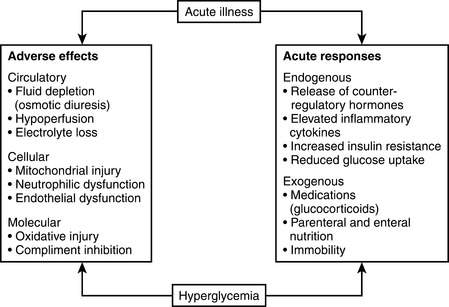Chapter 51 Management of Hyperglycemia in the Critically Ill
4 What is the relationship between hyperglycemia and acute illness?
The relationship between hyperglycemia and acute illness is complex. Severe hyperglycemia (>250 mg/dL) has been shown to have a negative impact on the vascular, hemodynamic, and immune systems. Hyperglycemia can also lead to electrolyte imbalance, mitochondrial injury, and both neutrophil and endothelial dysfunction. Acute illness increases the risk for hyperglycemia through the release of counterregulatory hormones, increased insulin resistance, and immobility. Figure 51-1 illustrates the relationship between acute illness and hyperglycemia.
9 What is the appropriate glycemic target for critically ill patients?
Recognizing the importance of glycemic control in critically ill patients, a number of professional societies have developed treatment guidelines and/or consensus statements that provide evidence-based glycemic targets. Although the glycemic targets are not identical, all of the groups advocate for good glycemic control while avoiding hypoglycemia (see Table 51-1).
Table 51-1 Summary of glycemic targets from the medical literature
| Professional society/consensus statement | Glycemic target for critically ill patients |
|---|---|
| American Diabetes Association | 140-180 mg/dL |
| American Association of Clinical Endocrinologists | 140-180 mg/dL |
| Surviving Sepsis Campaign | 150-180 mg/dL |
| American College of Physicians | 140-200 mg/dL |
| American Thoracic Society | <180 mg/dL (in patients undergoing cardiac surgery) |
Stay updated, free articles. Join our Telegram channel

Full access? Get Clinical Tree



